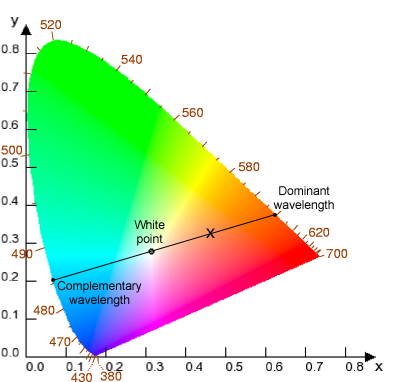Nanoparticles exhibit color because of the Surface Plasmon Resonance effect which is a resonance of the outer electron bands of the particles with light wavelengths.
Plasmon resonance occurs when light photons excite the outer electrons of the particles. The outer electrons on the metal particles jiggle like jello at light frequencies/wavelengths and absorb light corresponding to that resonance. The remaining colors pass through. So removing blue light leaves green and red which together make yellow. Bigger particles have a bigger outer electron cloud which makes them resonate a lower frequencies (more toward green) This shifts the transmitted color more toward red. Smaller particles have a smaller electron cloud which makes them resonate at higher frequency, more toward blue. This shifts the transmitted color more toward green.
Even smaller particles may have their resonant frequency in the ultraviolet region which is invisible to the human eye, making the solution look clear.
Its just like church bells on a much smaller scale. Big bells ring with low tones, small bells with high tones.
If the particles look white or gray, its because they are large enough to reflect all colors of light. So silver oxide particles and silver chloride have to be greater than 800nm in size which is the wavelength of red light.
The relationship of particle size to color is well known and is mathematically quantified by Mies and Rayleigh scattering theory.
For our use there are two important relationships.
The first is that the absorbed wavelength of a particle of silver is proportional to its diameter.
This means that if a particle grows by 10%, its absorbed wavelength will be 10% longer.
Remember that color is not an actual property of physical matter. Color is a subjective perception. Physical matter has absorbance, reflectance, transmittance, opacity, etc, but not color. Humans can perceive wavelengths from approximately 380 nanometers (bllue) to 800 nanometers (red). The color of nanoparticles that we perceive is the complement of the absorbed wavelength of the nanoparticle. That is, if the particle absorbs blue, it will transmit green and red wavelengths causing the human eye to perceive yellow (red + green = yellow)

This chart demonstrates the perceived color if a wavelength of 485nm is absorbed by the particle. The color will appear orange. If the absorbed color (left side of the chart) is shifted down to 435 nm, the perceived color will be pure yellow. Shifting the absorbance down slightly more to 430 adds a little green to the perceived color. Notice that shifting the absorbance from 435 to 430 makes an observable difference in color, and yet the absorbed wavelength is only different by about 1%. This means that the particle size is only about 1% different.
Also note that if the absorbed wavelength is less than 380, the absorbed wavelength will not make any visible difference, and hence, the observed CS will then appear clear.
The second important relationship given by Mies theory is that the intensity of the color varies as the 6th power of the particle size! This means that a decrease in particle size of only 1% will result in 6% less color. A 10% increase in particle size will make the solution look 50% darker!
Another consideration is that stabilizers bind to the nanoparticles weighing down their outer electron shell, the part of the particle that causes the Plasmon resonance. This has the effect of making the particle appear slightly larger than it is, and shifting color a little toward red.
The conclusion that can be made from this analysis is that very small differences in the size of the particles make very noticeable changes in the perceived color and intensity of a CS or CG solution.

Comments
Relationship of Particle Size to Color — No Comments
HTML tags allowed in your comment: <a href="" title=""> <abbr title=""> <acronym title=""> <b> <blockquote cite=""> <cite> <code> <del datetime=""> <em> <i> <q cite=""> <s> <strike> <strong>